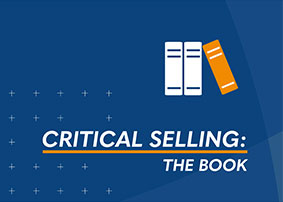Why Selling on Value is More Important Than Ever

Back in January, I wrote about why you need to sell on value rather than price. I used the example of a manufacturer experiencing raw material price spikes during economic changes. Then, two months later, COVID-19 came barreling down like a freight train, smashing into the world economy and causing a crisis arguably the most severe since the Great Depression.
There are real-world consequences to the sales world from the pandemic, and it’s what makes selling on value in these times even more vital than before.
- Buyers are scared.
While many places have opened up or are in the process of re-opening, there’s still a lot of uncertainty out there. We don’t know when, or even if, things will ever return to what one might consider normal. Uncertainty can be frightening, because it represents the possibility of chaos and loss of control (Hence, psychologists tell us, the toilet paper buying frenzy wasn’t about the TP itself – it was about a way to take control in a suddenly chaotic world).
When you have fearful buyers, you have risk-adverse buyers. For many, price becomes a focal point – revenues are down all over, and the budgets of the past simply aren’t there right now. Sure, you could discount to try to gain the business, but that means cutting further into margins. More importantly – and I’m bolding this for emphasis – The price of an item does not address a buyer’s fear. Knowing the value of an item does. When buyers are secure in the value of what you sell, they’re not nearly as scared – if at all.
- If you can’t explain your value, you’ll lose to someone who can.
While this is true in any business environment, if you can’t articulate what’s valuable about your offering and how that value benefits your customer’s needs and objectives, you won’t be a very successful sales rep. This becomes even more the case in tough selling times and situations.
So why, then, would you bother selling on price at all? If clarifying value for the customer is what results in sales (and it is), that value should be the bedrock of the way you approach selling. When you lead with value each and every sales conversation, expressing that value becomes second nature.
- Objections and challenges will both be fewer and easier to navigate with value.
As sales professionals, we’ve all heard variations of, “We’re not interested,” or “It’s too expensive for us” – often multiple times a day. In some cases, it’s true. But in many instances, it’s not accurate – beneath the rejection are the words, “We don’t see the value in this.”
Objections often arise because the buyer fails to see or understand your value. If you’re able to demonstrate where the value comes in for them, you’ll have a lot fewer obstacles, and the sales process will go much more smoothly. Conversely, selling on price often results in haggling and a debate over the final number – to say nothing of a greater likelihood of losing the deal, even when the economy is good.

- Account Planning (16)
- Awards (42)
- Client Testimonial (37)
- Personal Branding (21)
- Podcast (12)
- Research (77)
- Sales Career Development (90)
- Sales Coaching (165)
- Sales Consulting (141)
- Sales Culture (181)
- Sales Enablement (380)
- Sales Leadership (112)
- Sales Management (268)
- Sales Negotiation (11)
- Sales Prospecting (136)
- Sales Role-Playing (19)
- Sales Training (242)
- Selling Strategies (279)
- Soft Skills (78)
- Talent Management (101)
- Trusted Advisor (29)
- Virtual Selling (57)
- Webinar (13)




























